Wonders of Europe-6: Exciting trip to snow-filled Mt. Titlis and Jungfrau and Cruise in Lucerne Lake
By Dr. Eugene DSouza, Moodubelle
Bellevision Media Network
Udupi, 18 Sep 2013: To be in Switzerland, the ‘heaven on earth’ at least once in lifetime is the dream of everyone who is aware of the country’s beauty of nature, its lakes and snow capped mountain peaks. Any tour company that arranges trips to Europe includes Switzerland as one of the star attractions of the tour. On entering the Swiss territory on the previous evening, I could visualize as to why Switzerland attracts such a large number of foreign tourists.
On the morning of 17 July, our first task on the agenda was the trip to the snow-filled Titlis Mountain through cable cars in three stages. After breakfast we moved to the Engelberg Cableway station which was a mere five minutes drive from the hotel where we had spent the night. As many tourist buses make their way to the cableway station, the Engelberg authorities have made arrangement of a vast parking space.
As in other places of tourist attraction, here too we had to wait in the queue patiently waiting for our turn to board the six-seater cable car. As we waited in line for our turn, I could see front side of the cable cars being painted with the flags of different countries. I chanced upon the cable car that had the painting of Indian flag.
The cable cars were landing and sliding by the side of platform at regular intervals. The personnel of the cable company were seen ushering the tourists into the cable car and closing the door before it took off and carried the tourists to higher reaches of the mountain.
As our turn came, we hopped into the cable car which moved slowly and within a short period we were ‘airborne’. As the cable car moved to higher plain we could see the buildings and trees dwarfing below. We could clearly see the contours of the lake below and so also the cattle grazing.
We alighted from the smaller cable car at the second stage and boarded another rectangular shaped larger cable car that carried around 25 tourists. It took us still higher in the mountain and then once again we boarded the third circular cable car know as ‘Titlis Rotair’ for the last 600 meters of aerial journey which rotates 360 degrees giving the tourists a panoramic view of the entire mountainous region. This is the first revolving cable car in the world.
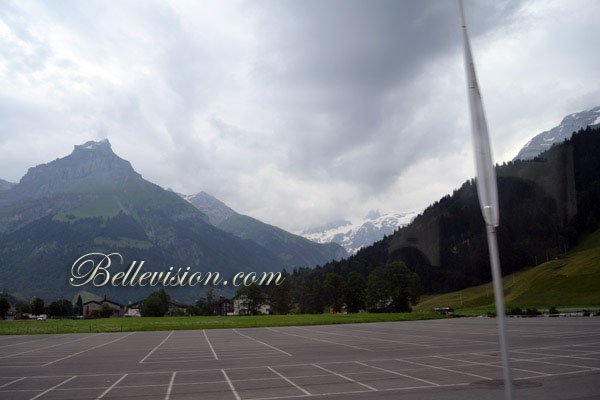
.jpg)
.jpg)
.jpg)
.jpg)
.jpg)
.jpg)
.jpg)
.jpg)
.jpg)
.jpg)
.jpg)
.jpg)
.jpg)
.jpg)
.jpg)
.jpg)
.jpg)
.jpg)
.jpg)
.jpg)
.jpg)
.jpg)
.jpg)
.jpg)
.jpg)
.jpg)
.jpg)
.jpg)
.jpg)
.jpg)
.jpg)
.jpg)
.jpg)
.jpg)
.jpg)
.jpg)
.jpg)
.jpg)
.jpg)
.jpg)
.jpg)
.jpg)
.jpg)
Having reached the topmost point on the Titlis Mountain in the cable car aerial journey, we climbed the terrace of the structure which houses souvenir shops and restaurants, we were exposed to heaps of snow. Those who could venture out played in the snow and others savoured the beauty of the snow-clad Alpine mountain range.
Walking a little further, I boarded an open chair lift with a horizontal protective bar. The chair lift know as the Ice-Flyer took me silently over the Glacier. The view of the glacier crevasses is spectacular at more than 3000 meters height. The Ice Flyer took me directly to the Glacier Park where I could see a number of tourists sliding the snow track squatting on snow rubber tubes.
The Glacier cave in the heart of the Titlis Glacier, ringed by glittering ice walls is another attraction which opens a whole new world to the tourists. This impressive cave takes visitors through a 150 meter long tunnel down to 20 meter under the glacier’s surface.
Mount Titlis with an height of 3,238 meters overlooks Engelberg. In a document of 1435, the mountain is called Tuttelsberg (Tutilos mountain), referencing to a man named Tutilos, who was probably a local farmer. The name, from Tutilos Berg, became Titlisberg and later Titlis.
The first ascent of Titlis was probably made in the year 1739. It was done by Ignaz Herz, J. E. Waser and two other men from Engelberg. The first written evidence of an ascent is found in the Engelberger Dokumente. They mention a party of four men that reached the summit in 1744. On 21 January 1904 the first ski ascent of Titlis was made by Joseph Kuster and Willi Amrhein. In March 1967 the cable car to Klein Titlis (3,032 m) was inaugurated. In December 2012, the Titlis Cliff Walk opened to commemorate the 100th anniversary of the Engelberg-Gerschnialp cableway.
After thoroughly enjoying the snow experience on Mount Titlis, we moved down in the same way and had lunch at the second stage of the cable way and boarded the smaller cable car and descended to Engelberg from where we headed to another exciting destination, the city of Lucerne.
In the city of Lucerne, we first visited the Lion Monument, a sculpture carved in a large granite stone. This Lion Monument, in which the Lion is shown in agony and about to die. It commemorates the Swiss Guards who were massacred in 1792 during the French Revolution, when revolutionaries stormed the Tuileries Palace in Paris, France. The American writer Mark Twain (1835–1910) praised the sculpture of a mortally-wounded lion as "the most mournful and moving piece of stone in the world.”
From the early 17th century, a regiment of Swiss mercenaries had served as part of the Royal Household of France. On 6 October 1789, King Louis XVI had been forced to move with his family from the Palace of Versailles to the Tuileries Palace in Paris. In June 1791 he tried to flee from France to a neighbouring country. On 10 August 1792, the revolutionaries stormed the palace and fighting broke out. More than 600 Swiss Guards defending the Tuileries were killed during the fighting or massacred after surrender. An estimated two hundred more died in prison of their wounds or were killed during the September Massacres that followed.
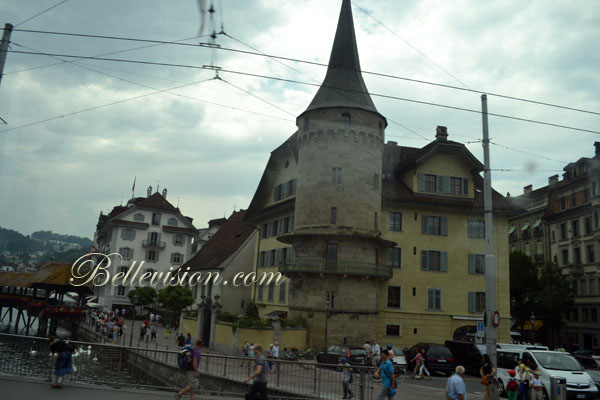
.jpg)
.jpg)
.jpg)
.jpg)
.jpg)
.jpg)
.jpg)
.jpg)
.jpg)
.jpg)
.jpg)
.jpg)
.jpg)
.jpg)
.jpg)
.jpg)
.jpg)
.jpg)
.jpg)
.jpg)
.jpg)
.jpg)
.jpg)
.jpg)
.jpg)
.jpg)
.jpg)
.jpg)
.jpg)
.jpg)
.jpg)
.jpg)
.jpg)
.jpg)
.jpg)
.jpg)
.jpg)
.jpg)
.jpg)
.jpg)
.jpg)
.jpg)
.jpg)
.jpg)
.jpg)
The initiative to create the Lion Monument was taken by Karl Pfyffer von Altishofen, an officer of the Guards who had been on leave in Lucerne at that time of the fight. He began collecting money in 1818 for the monument. The monument was designed by Danish sculptor Bertel Thorvaldsen, and finally carved n in 1820–21 by Lukas Ahorn, in a former sandstone quarry near Lucerne. Carved into the cliff face, the monument measures a staggering ten meters in length and six meters in height. The monument is dedicated “To the loyalty and bravery of the Swiss".
After viewing the Lion Monument we walked towards the city center with beautiful buildings and a vast lake that stretches far and wide. Lucerne is a beautiful small city in the heartland of Switzerland, across the lake. The first city to join the Swiss Confederation, today Lucerne is a lovely small city with a thriving tourism industry. Soon we came close to the historic Chapel Bridge, a landmark of Lucerne. It is said to be the oldest Woodbridge of Europe. The Bridge is made with wood and was built in 14th century as a protection for the city. It is quite interesting walking over the Bridge as one can see about 100 pictures of 12th century city life and Swiss history. Unfortunately the bridge burned down on 18th August 1993. Within a few months it was rebuilt.
The Chapel Bridge looks beautiful with flowers on both sides of the Bridge. Chapel Bridge and the Water Tower are prominent tourist sites in the central portion of Lucerne. A new vehicular bridge is close by that connects the two sides of the lake-city.
After crossing the Chapel Bridge and walking through the promenade, we crossed back through the vehicular bridge and sat down by the side of the lake as there was sufficient time for the cruise during which we were to have our ‘Cruise Dinner’. Many tourists were seen sitting by the side of the lake and feeding the birds, especially the geese as they slowly moved up and pecked the pieces of bread that were thrown at them.
At around six o’clock local time, the cruise boat arrived at the boarding point to pick us up. Entering the boat, we occupied the tables as the boat began to move away from the shore. As the boat moved further we could view the far off mountain ranges, cluster of fir and pine trees, patches of grass meadows and monuments and buildings making it a complete package of tourist delight.
Wine was served to the tourists as they enjoyed the beauty of the lake and its surroundings and listened to the sound of the traditional musical instrument of Switzerland- alphorn which is an archaic instrument, about 2.7 m [9 ft] long. It is made from a single log of wood, cut into two blocks from top to bottom, carved out and then put together again and wrapped up. There are no holes, flap-valve or anything similar to this instrument, so only natural tones can be produced when blowing the alphorn.
After sometime, dinner was served onboard the boat. Having finished the dinner, our tourist colleagues went to the upper deck and some of them began dancing to the tune of Indian music. The entire cruise experience in the Lucerne Lake with wine, dinner, dance and of course the lovely glimpses of the nature was an unforgettable episode in the tourist agenda of the ‘Wonders of Europe’ Tour.
The next day, on 18 July we started early morning to reach our most important destination of the day, namely, Jungfrau Mountain also known as ‘Top of Europe’. It was quite a distance and in between we just had a view of Zurich Lake and halted for some time at Interlaken Township located between two Alpine Lakes. It is said that Yash Chopra chose Interlaken to shoot his most popular movie-Dilwaale Dulaniya Le Jayenge (DDLJ) in 1995, directed by his son-Aditya Chopra starring Kajol and Shah Rukh Khan. In this way, it was Yash Chopra who has been credited by the Swiss popularizing Switzerland in general and Interlaken in particular among the Indian tourists.
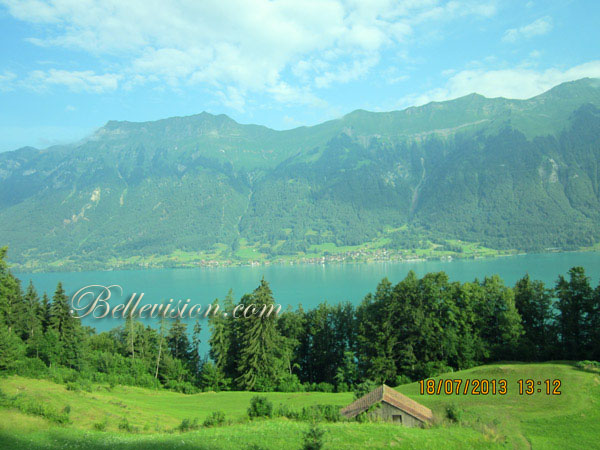
.jpg)
.jpg)
.jpg)
.jpg)
.jpg)
.jpg)
.jpg)
.jpg)
.jpg)
From Interlaken we arrived at the Trummelbach Falls. Alighting from the bus we walked for about ten minutes and reached the base of the falls. The Trümmelbach Falls are the world’s only glacier waterfalls that are accessible underground by lift, galleries, tunnels, paths and platforms.
The magnificent glacier fed Trümmelbach Falls, a series of 10 waterfalls in a cave-like environment, is hidden inside a mountain in the Lauterbrunnen Valley. It’s a natural UNESCO World Heritage site.
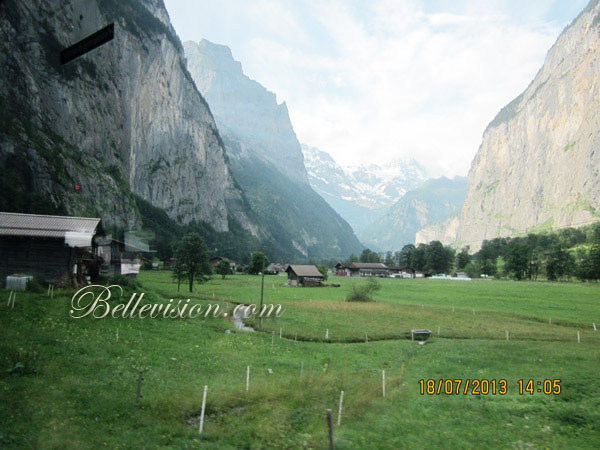
.jpg)
.jpg)
.jpg)
.jpg)
.jpg)
.jpg)
.jpg)
.jpg)
.jpg)
.jpg)
A tunnel elevator took us to a platform from where we could access the uppermost waterfalls. The path leads over a small bridge, up a few flights of stairs and walkways and partly through dimly lit tunnels to the highest waterfall. Freezing spray makes path and stairs slippery and the caves damp.
Melting glacier water flowing down from the Alpine Mountain form a powerful raging torrent that carries 20,000 liter water per second through the caves. The torrent carved its way through solid rock and debris over thousands of years and sculpted elegant and impressive shapes of rock formations. The result is spectacular and the thunder from gushing waters deafening.
Small lookouts and cutouts along the way provide viewing points to the ten chutes that fall into foaming pools and disappear into darkness. It is a spectacle of milky glacier water twisting, tumbling and making its way down over sculpted rocks and hitting the walls of the narrow slot canyon.
After reaching the highest chute i backtracked down to the lift platform. From here one can take the elevator or continue to walk back down to the entrance to see the last two of the ten chutes tumble into the Trümmelbach River. I walked down the remaining steps and came to the base of the waterfall.
From the Trummelbach Glacial Waterfalls we proceeded to Lauterbrunnen Railway station where we boarded the cogwheel yellow-green coloured train that took us through the sloppy Alpine mountain to Kleine Scheidegg station via Wengen. This section of the train journey gave us clearer view of the Jungfrau Mountain and the valley below. We saw verities of mountain flowers that swung in air as the train moved by.
On reaching the Kleine Scheidegg station we boarded another cogwheel train that had red colour which would take us to the Jungfrau station. The Jungfrau Railway runs 9 kilometers from Kleine Scheidegg to the highest railway station in Europe at Jungfrau which is at a height of 3,454 meters. The railway runs almost entirely within a tunnel built into mountain and contains two stations in the middle of the tunnel, where passengers can disembark to observe the neighbouring mountains through windows built into the mountainside.
After disembarking from the train we walked up to the top portion of the station structure. There is a hotel, two restaurants, an observatory, a research station, a small cinema, a ski school, and the "Ice Palace", a collection of elaborate ice sculptures. Another tunnel leads outside to a flat, snow-covered area, where one can walk around and look down to the glaciers as well as the surrounding mountains.
It was in 1893, industrialist Adolf Guyer-Zeller conceived of the idea for a railway tunnel to the Jungfrau to make the glaciated areas on the south more accessible. The building of the tunnel took 16 years and the summit station was finally opened in 1912. The goal was in fact to reach the summit of the Jungfrau with an elevator from the highest railway station inside the mountain. The complete project was not realized because of the outbreak of the First World War.
Gradually, after the end of the war and thereafter, the Jungfrau railway project continued with additional facilities being added. A large number of tourists who visit Switzerland make it a point to travel by the Jungfrau Railway and experience being at the ‘Top of Europe’ railway station enjoying the best of the Alpine Mountain.
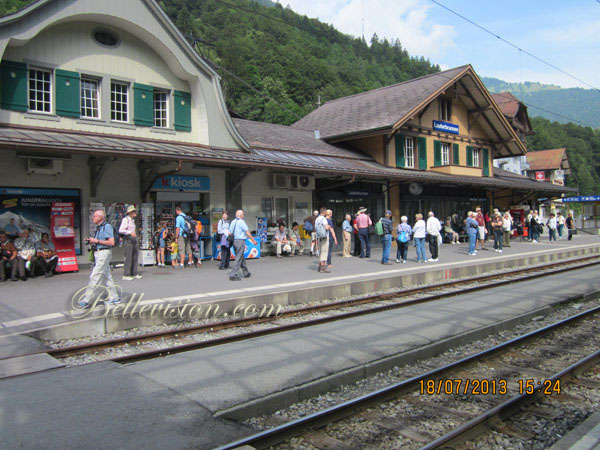
.jpg)
.jpg)
.jpg)
.jpg)
.jpg)
.jpg)
.jpg)
.jpg)
.jpg)
.jpg)
.jpg)
.jpg)
.jpg)
.jpg)
.jpg)
Having completed our sightseeing from the ‘Top of Europe’ , we once again boarded the Jungfrau Railway and returned to Lauterbrunnen in the same way as we had gone up to the Jungfrau station. Hopping into the waiting bus we returned to our hotel and spent the last night in Switzerland before leaving to Vaduz, capital of the Principality of Liechtenstein.
Though I had clicked hundreds of pictures on 18 July, right from Interlaken till Jungfrau, when checked in the evening, I found that the camera could not read the clicked pictures and it was a shock to me as I had lost the fruit of my entire day’s labour. Hence, for the narration in this episode of the travelogue from Interlaken to Jungfrau, I had to rely on some of the pictures clicked by my friend Ashok Badgujar and few internet pictures so that this part of the travelogue would become meaningful to the readers. For the rest of the tour, I inserted a fresh chip that worked well…
Also Read
Part 1 : ’Wonders of Europe’ - London in a Day
Part 2 : Memorable Tour Through Historic Paris and Enchanting Disneyland
Part 3: Onward to beautiful Brussels and classical Amsterdam
Part 4: Magnificent Cologne Cathedral-Architectural Wonder of Europe
Part 5: Through Black Forest to Cuckoo Clock Factory and Rhine Falls




 Write Comment
Write Comment E-Mail To a Friend
E-Mail To a Friend Facebook
Facebook Twitter
Twitter  Print
Print 















Very good photos!! dil ko thandak mili agar vahan pahnh jaun to jindgi ka khwab pura ho jay .